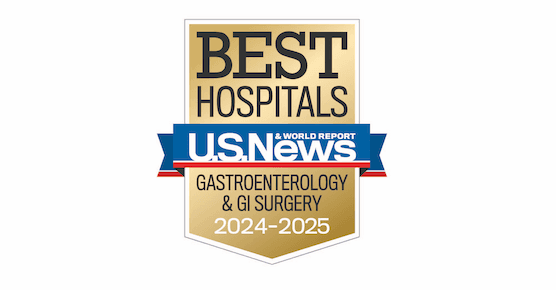Interventional Endoscopy Procedures & Services
Going Beyond Standard Endoscopic Care
Our interventional endoscopy team strives to push the boundaries of endoscopic technology for the benefit of our patients. Our complex endoscopic procedures can diagnose conditions early and spare patients from major surgery. We use the most innovative endoscopic techniques to provide minimally invasive solutions. Many of the advanced endoscopic techniques we use were developed or perfected by our physicians.
We collaborate with referring physicians to develop personalized treatment plans, and we keep them informed at every point in patient care. Our consultation and procedure turnaround time is fast — 24 to 36 hours.
We work with UChicago Medicine experts in a variety of specialties to provide a team approach to care. Our team also includes nurse coordinators who are dedicated to helping our patients navigate and understand their treatment, whether that is a simple, one-time procedure or requires ongoing care.
Our services include:
- Advanced imaging techniques to identify precancerous conditions, sometimes even before they can be found with standard endoscopy
- Endoscopic treatment of malignancies and obstruction of the GI tract and other complicated conditions, sparring patients from the risk of surgery
- Precise endoscopic diagnosis and staging of cancer, enabling referring physicians to plan the most appropriate and effective treatment
Many of the procedures we offer are available at only a handful of hospitals nationwide. These differentiating procedures include peroral endoscopic myotomy (POEM), endoscopic submucosal dissection (ESD) and photodynamic therapy (PDT).
Endoscopic Procedures
What is peroral endoscopic myotomy (POEM)?
Peroral endoscopic myotomy (POEM) is minimally invasive procedure that uses endoscopic technology to treat digestive and swallowing disorders. This incisionless technique offers quick recovery and treats rare digestive disorders such as achalasia, a disorder of the esophagus that makes it difficult to consume food.
During the procedure an endoscope is inserted into the mouth and moved through the throat creating a tunnel between layers of the esophagus. When the endoscope reaches the lower esophageal sphincter, an incision is made in the muscle, permanently opening the value.
UChicago Medicine is one of the few centers in Chicago and Illinois offering peroral endoscopic myotomy (POEM) to patients for the treatment of digestive and swallowing disorders.
What is endoscopic submucosal dissection (ESD)?
Endoscopic submucosal dissection (ESD) is a minimally invasive endoscopic resection technique to examine and remove growths from the lining of the GI tract. This includes Barrett's esophagus nodules, complex colon polyps and duodenal adenomas. This technique was developed as an alternative to standard surgical procedures. Due to the increased technical difficulty, ESD is only available at a few selected care centers in the United States.
Endoscopic resection is one of our team's main areas of research. We were one of the first groups in the nation to perform endoscopic mucosal resection (EMR). Our experience performing EMR spans 15 years and thousands of cases. Therefore, it is natural evolution for use to now perform ESD.
Endoscopic submucosal dissection (ESD) can be considered for:
- Superficial esophageal cancer (both squamous or adenocarcinoma)
- Early gastric cancer
- Early colorectal cancer (limited to the superficial submucosa)
- Non-lifting colorectal lesions
What is photodynamic therapy (PDT) for cholangiocarcinoma?
Cholangiocarcinoma is a relatively rare cancer of the bile ducts with approximately 5,000 cases annually in the United States. For more than 80 percent of patients, the disease is unresectable. Therapy options traditionally have been limited to chemotherapy and palliative bile duct stenting to relieve jaundice.
In photodynamic therapy (PDT), the patient receives an IV porphyrin sensitizer 48 hours prior to endoscopic application of light to the tumor with the purpose of causing cell death. The light is delivered via a flexible fiber during endoscopic retrograde cholangiopancreatography (ERCP) at the time of biliary stent placement or exchange.
Although data on the use of PDT in cholangiocarcinoma is limited, initial studies in patients with unresectable disease have suggested the treatment not only aids biliary decompression, but also improves survival through actual tumor destruction. The main side effect of this therapy is severe photosensitivity for 30 days for which the patients must be counseled.
UChicago CERT is the only center in the city to offer PDT for therapy of unresectable cholangiocarcinoma.
We also have expertise in:
- Endoscopic ultrasound (EUS) with fine needle aspiration (FNA)
- Celiac plexus neurolysis
- Endoscopic retrograde cholangiopancreatography (ERCP)
- Cholangioscopy
- Photodynamic therapy (PDT) ablation of cholangiocarcinoma
- Lithotripsy of large biliary and pancreatic duct stones
- Ampullectomy
- Endoscopic mucosal resection (EMR)
- Endoscopic submucosal dissection (ESD)
- Complex polypectomy in the colon and duodenum
- Radiofrequency ablation (RFA) and cryotherapy
- Pancreatic pseudocyst drainage and necrosectomy
- Palliative stenting of GI tract and pancreaticobiliary malignancies
- Extracorporeal shock wave lithotripsy (ESWL) for pancreatic stones
- Peroral endoscopic myotomy (POEM)
- Zenker's diverticulotomy/ myotomy

Nationally Ranked in Gastroenterology and GI Surgery
According to U.S. News & World Report's 2024-25 Rankings.
Learn more about U.S. News Best Hospitals